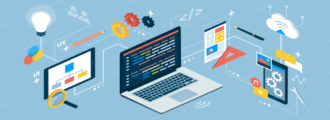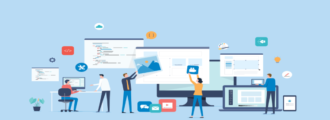You’ve heard the news that Salesforce isn’t updating Classic anymore, you’ve done your research on all the enhanced features in Lightning Experience, you’ve read about how your org will operate in the new interface, and now you’re ready to make the switch from Salesforce Classic to Salesforce Lightning. Here’s how to do it.
Things to Consider Before You Switch
Switching from Classic to Lightning is a bit like a reimplementation of Salesforce. True, you won’t have to import data, recreate your custom fields, or set up your security model, but you will need to consider things like technical debt (i.e., custom code that might not work in Lightning) and reevaluate your business processes to see if there’s a more efficient way to accomplish your goals in the new system.
How to Roll Out Lightning Experience
As with any major software change, you’ll need to create a plan of attack before getting started. We recommend a rollout strategy for Lightning Experience in three stages: Discovery, Rollout, and Optimization.
Discovery
In the Discovery phase, you’re learning about what Lightning Experience has to offer, comparing its features to Salesforce Classic, identifying who the primary stakeholders will be (as well as an executive sponsor), conducting a gap analysis, and all the other standard to-do’s involved in any major software upgrade.
The Rollout
- Identify a pilot group of users to bravely explore Lightning Experience.
- We go into more detail on this step in the “Set Up Users” section below.
- Define what success looks like for you.
- Create a schedule.
- Ensure that you train your users. (Salesforce has an awesome series of units in Trailhead to educate users on all the basics.)
- Customize and test (and rinse and repeat)
- Important note: No plan survives contact with the enemy. In this case, the “enemy” is Murphy’s Law, so be sure to add extra time to your plan than you think you might need, be ready for issues that might crop up that you didn’t anticipate, and ensure lines of communication are open throughout the changeover (and afterward).
Optimization
After you’ve officially rolled things out, compare your progress with your defined goals and make adjustments as necessary—dashboards and reports are a great way to measure this. You’ll also need to make sure you’re regularly communicating with users to look for pain points as well as opportunities for further training.
Set Up Users
Thanks to custom profiles and permission sets, Salesforce makes it pretty easy to fine-tune access to Lightning Experience. If you’re planning on sending a small group of bold explorers into Lightning Experience, this is the stage where you’ll decide who those people are and let the system know. (Or, if you want to let everybody loose in a brave new world, you can do that too.)
- We recommend a phased transition, where companies pick a department like sales, for example, to make the switch first. Your pilot group can evaluate the features offered by Lightning, and you can use their feedback to iterate on your next implementation.
User setup will also allow you to decide who will automatically get switched to Lightning Experience, who will only switch over from Classic when they choose to, and who won’t be able to switch back to the old interface.
How to Officially Turn on Lightning Experience
The Migration Assistant makes it simple to turn on Lightning Experience. All you have to do to officially flip the metaphorical switch is to navigate to Setup in Salesforce Classic and click the Get Started button in the Migration Assistant tile.
That will bring you to the “Turn It On” tab where you’ll click the button at the bottom to enable Lightning Experience. It’s that easy. (Also, feel free to shout, “It’s alive!” and let out your best maniacal laugh.)
Hopefully, you feel a bit more comfortable about switching from Salesforce Classic to Salesforce Lightning Experience, but if you need more expertise, contact Surety Systems today. Our team of senior-Level Salesforce consultants is like a group of experienced jungle guides who can help you hack through the thickets of confusion and arrive safely at your CRM destination.



